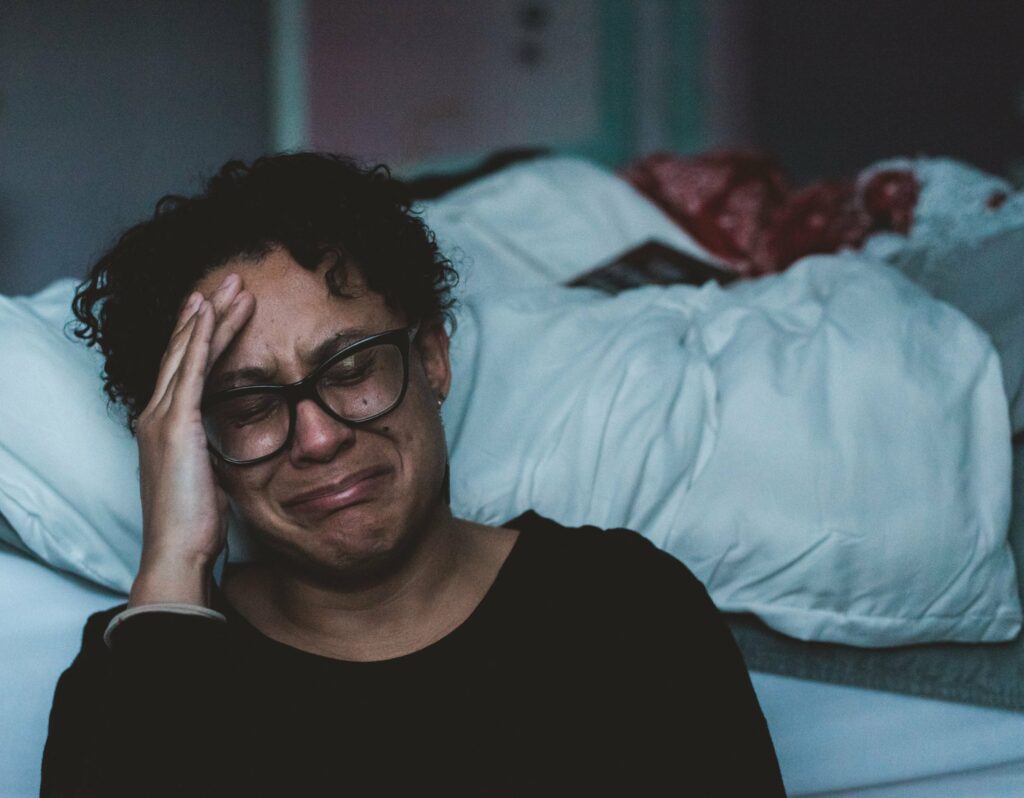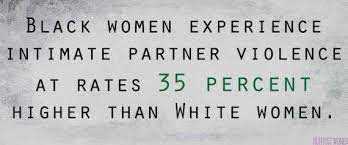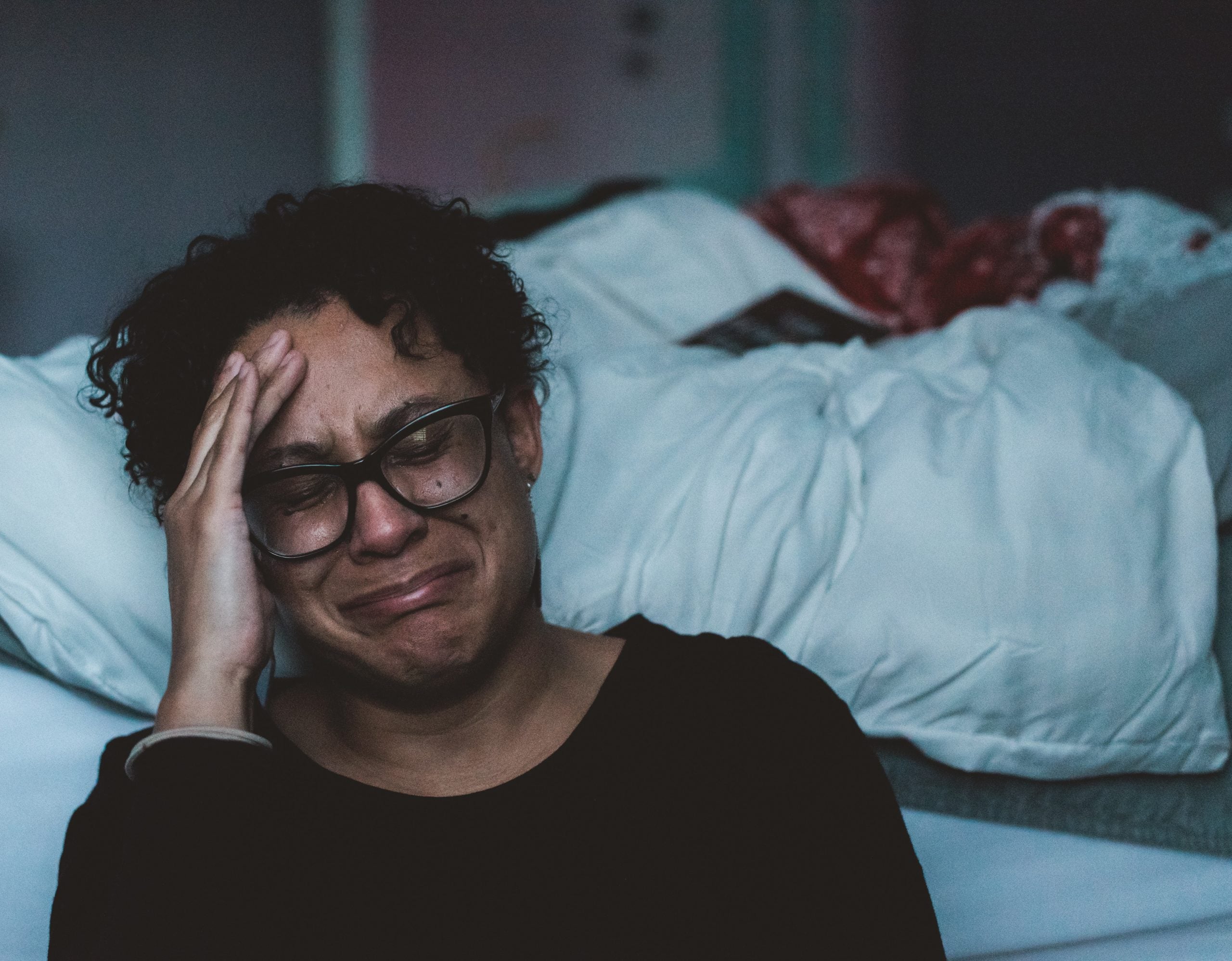Intimate Partner Violence In the Black Community & the Devastating Impact on Black Women and Girls!

Intimate Partner Violence against Black women in the U.S. is a rising concern. A friend recently forwarded me a news story about a young Black male shooting five Black women. He was assaulting his girlfriend, and the other four women were attempting to help her. While the girlfriend is expected to survive, two of the five women shot by this Black male did not. This article is just one more reminder of the elephant in the room in the Black community.
According to the 2010-2012 National Intimate Partner and Sexual Violence Survey, nationally, 45 percent of Black women experienced contact sexual violence, physical violence, and/or stalking by an intimate partner in their lifetime. The same survey found that 40 percent of Black men experienced the same reality. The empirical data available on the subject suggests that Black men and Black women experience some form of intimate partner violence at nearly the same rate. However, Black women are far more likely to be killed by an intimate partner than Black men.
According to a 2010-2012 survey, approximately 16 percent of Black women were stalked by an intimate partner during their lifetime.[1]
According to the CDC, homicide remains one of the leading causes of death for Black women 44 and younger. In 2015, homicide was declared the cause of death for 3,519 women and girls. Nearly half of these homicides were at the hand of a current or former intimate partner. It is worth noting that rates of homicide for females vary by race and ethnicity.
In my 19th book, Born in Captivity: Psychopathology As A Legacy Of Slavery, I go to great lengths to highlight the pathology of violence in the Black community. I point out that violence is usually an act of rage and passion, which is predominantly associated with propinquity. In other words, acts of violence are usually carried out against those within the same environment. While the numbers vary slightly, violence and murder in all races and ethnicities are usually perpetrated by someone within the racial enclave.
When it comes to violence within the Black community, the concern is the rate at which violence is carried out against Black women compared to rates of violence against women in other races. In 2017, Black victims were significantly more likely to be killed by an acquaintance (29%) than White victims (15%).[2]
We must develop the capacity to understand the numbers while viewing the reality outside of the numbers. I believe that we cannot afford to view our women and girls as numbers. The numbers must help us understand the magnitude of the problem, but we must possess the capacity to interject the human element into the equation. The suffering of Blacks viewed through the lens of abstract numbers does not provide a vivid portrait of the devastation and pain experienced within the community as a result of endogenous encroachments on our women and girls.
Outside of the science academy, we must gain a lucid perspicacity of the culture and historical influences driving this violence pathology.
When studying African American adolescent and young adult male violence, I discovered five significant factors that influence violence among African American adolescent and young adult males — allowing us to predict which males are likely to commit acts of violence. These five factors are:
- The feeling of being disrespected
- Lack of proper racial socialization
- Witnessing violence (element of desensitization)
- Victim of violence (element of desensitization & rage trigger)
- Urban Hassle (sirens, gunfire, drug activity, gang activity, etc.)
Understanding these influences provides insight into the pathology of violence. However, the awareness and understanding of these influencers do not adequately explain the heightened acts of violence against Black women by Black males. Intimate partner violence and homicide are not new phenomena. Social media has brought this nefarious force front and center. What used to be swept under the rug is now being uncovered.
One must ask why it is happening and examine why those who disapprove do nothing about it — especially Black men. If we are honest, we have failed miserably in providing our women with a safe space to exist and thrive.
Recently, there was a story about a woman being raped on a commuter train in broad daylight while everyone filmed the incident with their phone cameras. Violence against Black women appears to be culturally acceptable. The inability or unwillingness of Black men to intervene on behalf of Black women under duress is an entirely different story.
The Black man seems to be a ticking timebomb, and the Black woman has become collateral damage.
“It is easier to build strong children than to repair broken men.” ~ Frederick Douglass
Through the Black Men Lead rite of passage initiative, the first principle of manhood is that a Black man never harms or disrespects a Black woman. We must empower our children through self-awareness — providing a clear understanding of what we expect of them, as well as what will not be tolerated by them.
One of the things that I love about being an equal-opportunity accountability specialist (I just made that up) is that I have addressed virtually every sub-group in the African American collective. So, I have no reason to become concerned with how one group will feel when I call them to the mat. This truth is definitely on point when it comes to Black men because I am one, so when I address black men, I begin with myself.

The Failure of Black Men to Protect Black Women
Those of you who know me understand that I devote a great deal of my time to research to gain a more lucid and operational perspicacity of the current enigmatic dilemma that we have found ourselves unable to solve. I am currently in the second phase of a four-phase, five-year research project focused on cognitive dysfunctionality and its impact on African Americans’ social mobility, prosocial behavior, and mental health. The more I dig, the more amazed I become at the complex nature of our dilemma. It is a dilemma that has exogenous and endogenous influences. While the elements and components are immensely complex, we have everything we need to overcome every one of them within our grasp.
My goal is to be at the forefront of the effort to develop and implement strategies that will help us dismantle the nefarious mechanisms of white supremacy racism and confront the enemies within. The enemies within include the destruction of the family nucleus, disunity, animosity between the black man and the Black woman, and more. There is an African proverb that says:
“If there is no enemy within, the enemy on the outside can do you no harm.”


Anyone who knows me is aware that one of my passions is the restoration of the Black family nucleus. The black man has to reclaim his role as leader, provider, protector, and covering for the family to be restored. So, let’s talk about what that looks like for a brief moment.
This article is not meant to be a comprehensive examination of the current state of Black men in America, that will come in due time. This article is simply a clarion that is being sounded with hopes of awakening the lion within the Black man because currently, the Black man slumbers in a catatonic state in which he has become completely consumed with himself. The level of narcissism at which the average Black man exists is exceptionally ludicrous. When I examine the performance of the Black man, I examine him in the light of his design. You see, design is indicative of purpose. You can discover the purpose of a thing by pondering its design.
When I examine the design of the Black man, I see that he is exceptionally strong from a physical perspective, indicating that he is equipped to perform extreme physical activities. After examining the historical role of the black man, I find that he once used that physical strength to hunt and provide for his family, which included his woman (wife), his progeny, and even the aging parents of both his wife and himself. Historically, the black man has also used his strength to provide protection for his family, being a physical and spiritual covering for his wife. He was willing to lay down his life to ensure the safety of those underneath his covering, especially his wife.
The intricate and exceptional design of the black man is not limited to his physical prowess. He is intellectually and spiritually equipped with the gift of projective and lateral thought. In other words, his mind is capable of conceiving a long-term vision, and his ability to think outside of the box provides him with an innovative and creative capacity to create that which does not yet exist. So, the man is a provider, a protector, a visionary, a leader, a creator, and more. Still, unfortunately, his relatively brief sojourn in the U.S. has challenged his resolve and focus on fulfilling his destiny as the collective progenitor of his race. He has forgotten his greatness, his character, and his purpose. He has abandoned the covenant relationship with his woman.
The black man now suffers from a fragmented identity. He has experienced an extrication from the holistic nature of his existence, so he finds himself overconsumed with one particular element as a result of his fragmentation — expressing the manifestation of a massive identity crisis. Some black men are completely consumed by pornographic preoccupation, meaning that all they think about are sexual conquests. They measure their manhood by how many women they can bed down. They have absolutely no affinity to the responsibility to protect the women they are conquering.
Then, the Black man has bought into the pseudo-value of materialism, so he spends all of his time acquiring things that actually have no value. All he does is buy and brag. Then there is the hyper-violent black man, who expresses the frustration he feels as a result of his emasculation through perpetuating violence, most often against his own.
In his fragmented identity, the black man has lost his sense of responsibility, and this responsibility is first filial in nature, with the need to protect the black woman at the forefront. I have said this many times before, and I will once again express this truth here. No woman on the face of the earth has been unprotected at the level of the black woman. No woman has been the victim of incest at the level of the black woman. No woman has been molested and raped at the level of the black woman. No woman has been forced to raise the progeny of a man who found it to be an acceptable course of action to procreate with her and then abandon his progeny for her to raise. Long before I said it, Malcolm X spoke on it, and things have gotten much worse since his diatribe on the matter.
Support the inner-city programs and initiatives of The Odyssey Project!

Conservative numbers suggest that at least 60 percent of black females experience some form of abuse before the age of 18, which is absolutely unacceptable. The most difficult fact associated with this truth is the fact that far too often, the person who should have been her protector, her father, was the person abusing her. Blacks account for a disproportionate number of intimate partner homicides. One in three African American women are victims of intimate partner violence. These numbers are unacceptable.
Far too often, I see our women on the front line fighting for causes that our men should be leading. Far too often, black men are too comfortable with non-black men disrespecting our women. This is absolutely unacceptable. It needs to be made perfectly clear that disrespecting or harming our women and children will be dealt with is the most decisive of ways.
I am calling the black man to awaken from his slumber. Yes, there was a time when you were sold away from your family. Yes, there was a time in which you would be lynched and castrated for speaking up for your woman. Yes, there was a time that you were not allowed to bond with your progeny for fear that you would rise to fight for their freedom. All of those impediments are no longer an issue. Yes, you are facing an arduous struggle to rise, but you are built for it. So, step up and meet your moment. Step up and attack the path to your destiny. Stand up and make your presence felt.
Intimate Partner Violence ~ To My Black Sisters, Mothers and Daughters
There is no denying that you have been through a great deal of suffering over the last four centuries. You are battling generational trauma, matriarchal bitterness, and perpetual disappointment. You have been forced to deal with the terror of child molestation and incest. You have been forced to raise children on your own, with meager means. You have had to deal with the heartache associated with the abandonment caused by a man who said he loved you, while stepping on your heart, so, on behalf of every black man who has caused you harm, I personally apologize. I apologize in proxy because you may never get that apology you are looking for, but you are going to have to move forward. Your past can no longer be an excuse for your current failures.
For too long, you have carried the bitterness and hurt that did not belong to you. Your mother’s pain is her pain. Your grandmother’s bitterness and brokenness is not yours to mend, and even your brokenness is overdue for healing. Your perpetual state of pain and brokenness has led you on a path of destruction where you have destroyed multitudinous opportunities for happiness because you are hell-bent on making the current man pay for the transgressions of someone in your past. I know you are hurting, but it has to stop here; it is time to heal. If you need help, then seek professional help. If you arent clear on what to do, contact this organization at info@theodysseyproject21.com to learn what you need to do.
I am committed to seeing my people experience victorious living, and I am willing to take this fight for complete and total healing, as well as liberation, all the way. I challenge you to join me. I challenge you to come from behind the keyboard and own your destiny on the battlefield. It is time to unleash the lion in you. ~ Rick Wallace, Ph.D.Psy.D.
References
Baloyi, M. E. (2020). Black self-hatred: Regaining self-worth – From decolonisation towards reconciliation in South Africa – A practical theological appraisal. Theologia Viatorum, Theologia Viatorum 44(1) DOI:10.4102/TV.v44i1.33.
Gunn, J. C. (1978). Psychopathological Effects of Violence. U.S. Department of Justice Office of Justice Programs.
Hargrove, S. (2018). Intimate Partner Violence In the Black Community. The National Center on Violence Against Black Women in the Black Community.
Petrosky, E., Blair, J., Betz, C., Fowler, K., Jack, S., & Lyons, B. (2014). Racial and Ethic Differences in Homicides of Adult Women and the Role of Intimate Partner Homicide. MMWR – Morbidity and Mortality Weekly Report, 66(28), 741.
Smith, S., Chen, J., Basile, K., Gilbet, I., Merrick, M., Patel, N., . . . Jain, A. (2017). The National Intimate Partner and Sexual Violence Survey. National Center for Injury Prevention and Control. Centers for Disease Control and Prevention.
Stevenson, H. C. (2006). Parents’ Ethnic-Racial Socialization Practices: A Review of Research and Directions for Future Study. American Psychological Association, 1-24.
Stevenson, H. C. (2015). Development of the Teenager Experience of Racial Socialization Scale: Correlates of Race-Related Socialization Frequency from the Perspective of Black Youth. The Journal of Black Psychology.
Stevenson, H., Herrero-Taylor, T., Cameron, R., & Davis, G. (2002). Mitigating Instigation: Cultural Phenomenonlogical Influences of Anger and Fighting Among “Big-Boned: and “Baby-faced” African American Youth. Journal of Youth and Adolescence.
Wallace, D. (2007). Black Male Gender Role Socialization and the Performance of Masulinity in Love Relationships. Department of AFrican American Studies at Temple University.
Wallace, R. (2015). Collective Cognitive-bias Reality Syndrome. The Odyssey Project.
Wallace, R. (2016). Racial Trauma & African Americans. The Odyssey Project.
Wallace, R. (2017). Born in Captivity: Psychopathology As a Legacy of Slavery. Houston, TX: Odyssey Media Group & Publishing.
Wallace, R. (2018). The Burden of Depression Among African American Women. The Odyssey Project Research Department.
Wallace, R. (2020). The Undoing of the African American Mind. Houston: Odyssey Media Group & Publishing.
[1] (Smith, et al., 2017)
[2] (Petrosky, et al., 2014)
